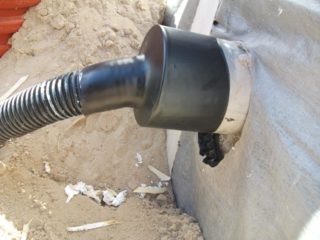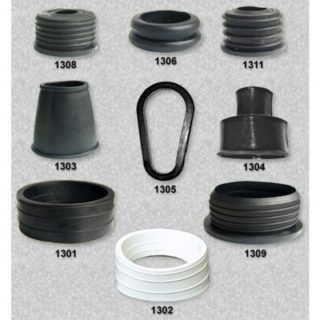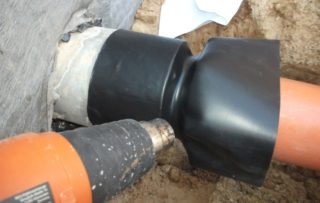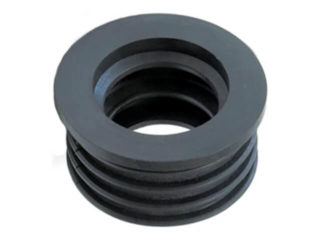The principle of gravity implies the operation of the drainage system without pressure, however, even in this case, leaks appear at the joints. Rubber seals for sewer pipes increase the efficiency and durability of the drainage system, so no pipe connection is complete without them. They are used in the outlets of bidets and toilets, when installing drains from sinks, bathtubs and household appliances. The main purpose of the products is to create tight joints and prevent leaks. The service life of the seals is long enough, but if necessary, they are easily replaced.
Definition and purpose of the sewer cuff

Various materials are used for manufacturing. Products in the form of corrugated pipes and rings are intended for use in industry and in residential buildings. Elastic polyurethane, silicone and rubber elements are used to seal joints of plastic pipes, fittings, various types of adapters, giving them strength and eliminating leaks.
Parts are classified by purpose:
- Rods have a seat between the rod and the inner surface of the cylinder. Provide tightness during the translational and reciprocating movement of the rod.
- Piston pistons are used to prevent the penetration of the working medium into the clearances between the piston and the hydraulic cylinder. The advantage of using them is to preserve the freedom of movement of moving elements.
- Universal ones can work in any conditions.
Depending on the type of connection, the cuffs can be sealing, providing reliable tightness, and transitional, allowing you to easily connect elements of different diameters.
Manufacturing material
Raw materials for the production of seals are selected depending on the operating conditions of the product and the corresponding physical and chemical properties of the substance. The material must meet the basic requirements: elasticity, strength, budget, the ability to withstand temperature changes, long service life.
Best of all, the conditions are matched by rubber, from which various models of seals and adapters are made. To give the material the desired properties, silicone, rubber and polyurethane are added to the rubber compound. The resulting compound gives rubber products additional advantages:
- resistance to corrosive chemicals;
- strength;
- reliability;
- resistance to temperature extremes and pressure of the medium.
When carrying out external and internal sewage from cast iron pipes, other types of seals are used. The connections are caulked with a harness that is treated with resin, making sure that it does not fall into the pipe and cause a blockage.
Types and sizes of cuffs

The seals can be installed both internally and externally. In the first case, they serve to connect plastic pipes of different diameters or to connect washing machines and dishwashers to the drainage system. If it is necessary to connect pipes without sockets, the seals are mounted on top of the parts.
A transitional sewer collar provides a connection between cast iron bends and plastic pipes. The length of the adapter with D 124/110 is 80 mm and is used to connect toilets, with D 72/50 - 110 mm for connecting other plumbing fixtures.
The dimensions of the O-rings correspond to the diameters of standard pipes 32-100 mm, and the length can vary from 25 to 120 mm. Seals 50 * 40, 50 * 25, 50 * 32 are used when connecting washing machines, sinks, washbasins, showers, dishwashers.
Installation features
There are two ways to install the seals. The choice depends on the presence of a cast iron socket.
If the sewer pipes are in good condition:
- Using a chisel, clean the socket of the coaling material and mortar.
- Remove the old item.
- Prepare the expansion of the cast-iron branch, remove the dirt and wipe it with a rag.
- Apply sealant to the outside of the rubber seal and insert it into the socket.
It is not required to additionally apply silicone to the outside of the pipeline, since after drying a reliable connection of the elements is formed.

In cases where it is not possible to remove the old sewer pipes, they are cut off, the edge is made in the form of a cone to ensure easy installation. Since the drainage system is usually active in multi-storey buildings, it is better to choose the morning time for work, when most of the neighbors are at work.
Shut off the hot and cold water in the basement to reduce the amount of drains. During the preparatory work, the open sewer pipe is plugged with a rag to block access to gases and dirty water. The cut is cleaned of chipping so that in the future they do not cause the formation of garbage jams.
In the absence of a socket, use the second method:
- Apply silicone to the inside of the fitting.
- Pull the prepared rubber seal onto the cut end of the cast iron pipe.
- Run the wiring from plastic pipes.
When installing installations, there are times when it is necessary to connect a branch pipe with a diameter of 90 mm or 95 mm to an ordinary cast iron sewage system with a d 110 mm. In this case, the Geberit adapter 367928 is used. It fits perfectly into the cast-iron socket, and on the other hand allows the connection of a plastic product of a non-standard size. To facilitate installation, liquid soap is applied to the parts. Automotive oil is sometimes used, but it can reduce the performance of the rubber product, shortening the life of the rubber product.
When connecting pipes of 95 mm and 100 mm to a standard sewage system, cuffs are used. They can be straight or eccentric. The cast iron pipe has a socket, so the connection will not be tight. In this case, a piece of pipe 5 cm long is cut off, coated with liquid soap. Then the resulting ring is put on the product, which already sits tightly into the bell. A product with an eccentric saves space in the bathroom, it is enough to turn it to the desired position, in which the mounting elements are deflected towards the drain pipe.
Advantages and disadvantages of cuffs for sewer pipes

Advantages of rubber products:
- good performance characteristics;
- long service life;
- low cost;
- the use of modern technologies in manufacturing, quality control at all stages of production;
- resistance to medium pressure within 0.5 atm. up to 1.5 atm.;
- a wide range of;
In cast-iron sewer sockets, exclusively rubber rings are used, which have high elasticity and strength. The seal prevents leaks, but the lack of a part in its exactingness to the state of cast-iron sockets. Even with minor chips, the tightness is broken.
The cost of the products is low, for example, an Ostendorf 110 mm sealing collar can be purchased for 175 rubles, a two-leaf reinforced product with d 50 mm - for 5 rubles. A three-blade adapter with dimensions 25 * 50.32 * 50, 40 * 50, 50 * 73, 110 * 123 will cost from 9 to 51 rubles.
Fire collar REHAU RAUPIANO compact 75 Germany made of polypropylene costs 3457 rubles.








